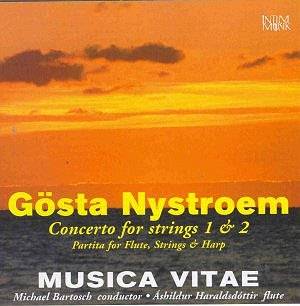‘I cultivate absolute,
pure music, but I am oddly enough at
the same time an unrepentant romantic’;
thus the Swedish composer Gösta
Nystroem in 1959.
Sweden's Intim Musik
have been building a catalogue that
takes in both Swedish music and Scandinavian
artists performing music from their
own and other peoples' mainstreams.
Their desirable collection of Nystroem
songs has been reviewed
on this site. That anthology is
now joined by a disc containing world
premieres of Nystroem's two Concertos
for string orchestra. Each is in three
movements and approaches thirty minutes
playing time.
The notes for this
release are by Lennart Reimers who tells
us the Nystroem was born in the deep
woods of Dalecarlia, raised in the Stockholm
archipelago, lived for twelve years
(1920-1932) in France and spent his
last years on Sweden's west coast. Even
during his Parisian sojourn he holidayed
in and had his official domicile at
Särö - the home of his wife
who died during the early 1950s. The
influence of landscape brings much more
subtle tones and oblique language than
that experienced in the romantic music
of that other Swedish poet of the west
coast - Atterberg. Atterberg’s Symphony
No. 3 West Coast Pictures is
a hymn to impressionistic romance yet
more powerful than Bantock’s Hebridean
Symphony.
Both the Sinfonia
Breve (on Caprice coupled with Ishavet
- Arctic Ocean) and the Concerto
No. 1 were written towards the end of
Nystroem’s Parisian adventure. The First
Concerto is not in the same stream
as Sinfonia del Mare or Songs
by the Sea, the works which won
the hearts of romantic traditionalists
in the 1950s. Here he is more objective,
even severe. The names of Hindemith,
Piston, Berkeley and, up to a point,
Honegger are prominent among the influences
you may think of. There are touching
moments as in the stillnesses in the
Grave sections of the first movement
and in the drawing of breath in the
finale - allegro con marcato.
For a moment at 10.20 a folk-accented
theme sings out. Overall this is a work
of grave rather than yielding pleasures.
While the First Concerto
was a completely unknown quantity, at
least for this listener, the Second
was familiar. Good friends in Sweden
and in the USA had over the years copied
to me two radio broadcasts of this work.
Both involved the massed strings of
the Swedish Radio Symphony Orchestra.
The first was presumably from the 1970s
and was conducted by Sixten Ehrling
(b.1918) who with Stig Westerberg (1918-1999)
was the champion of Swedish music. These
two conductors from the 1950s onwards
carried forward the ‘mantle’ of Tor
Mann (1894-1974). Ehrling’s heritage
adorns the catalogues of radio broadcast
collectors and of the commercial lists
of the Caprice label. Ehrling was to
Swedish music what Boult was to British
music though I fancy that his temperament
had about it more of Barbirolli than
the later ramrod rigour of the sixty-plus
Boult. Ehrling’s version of the Second
Concerto blisters paint and the central
movement, a scorching Bergian adagio,
is memorable for its concentrated regret.
The second radio tape had Hubert Soudant
(b.1946) conducting the Radio Orchestra
in 1982. Soudant revels in the grand
guignol and angst and turns in an impressively
concentrated performance.
The Second Concerto
is given a dramatic performance
and recording. Impressions crowd in:
sinister pianissimo shudders, melodramatic,
even playful (tr.9 3.21) writing, sometimes
tremulous or plaintive. The clatter
of wood bows at 6.20 in the first movement
sharply accents the rhythmic life of
the movement. This is an active, dynamic
work so if you like the Bridge Variations
by Britten and the Bartók
Music for strings, percussion and
celesta, but somehow more
humane than both, then this is certainly
for you. Extremely touching high and
quiet violins at 4.00 in the finale
contrast with striding acid-searing
strings: part Del Mare and part
Vaughan Williams’ Sixth Symphony.
By the time Nystroem
had got to the Second Concerto much
of his range had been purged of the
eloquent romance that burns at its peak
in the Sinfonia del Mare (1948).
However this returns pianissimo towards
the middle of the finale with a touching
memory of his early subjective unashamed
romantic manner. While lacking the corrosive
acidity of Shostakovich the Second Concerto
will appeal to you strongly if you like
the Barshai transcriptions of the Quartets.
The music at times suggests a link with
the intense string writing in Hindemith’s
Mathis der Maler and Nobilissma
Visione and at others with the open-air
musculature of Tippett’s Double Concerto
without Tippett’s melting melodic ecstasy.
The Partita
is placed between the two concertos.
Here the mood is familiar and the atmosphere
more relaxed. There is restraint but
this is romantically ingratiating music,
dignified, cool, shaded in Gallic tones
with recollections of Valses Nobles
et Sentimentales prominent in the
first movement and in the Canto semplice
(tr.7). Of flute and harp it is
the flute that adds the strongest flavour
in this Szymanowski-dedicated piece.
Long distances and the loneliness of
sea-wastes hang heavily over the adagio
(tr.6). If you were wondering, Nystroem
knew Szymanowski from their shared Parisian
years. The two were friends and the
only moment when the Swedish composer's
Partita sounds at all like the
Polish composer's music is for one brief
episode in the Lento first movement
although a song of his is apparently
quoted in the adagio. The hunted
and thudding chesty rhythmic hammering
in the finale recalls Herrmann's score
for Psycho (the night drive though
the rain) and the Waxman Sinfonietta
for Strings. Film noir in the making.
The Partita
is here given its second recording on
this label. The first is on IMCD
018 recorded at the Gothenburg Concert
Hall in 1992 with Göran Marcusson
(flute).
Adherents of the music of Honegger,
Hindemith and Bartók will love
this and should not delay. Nystroem
admirers (a growing band) will already
have placed their orders.
Rob Barnett
